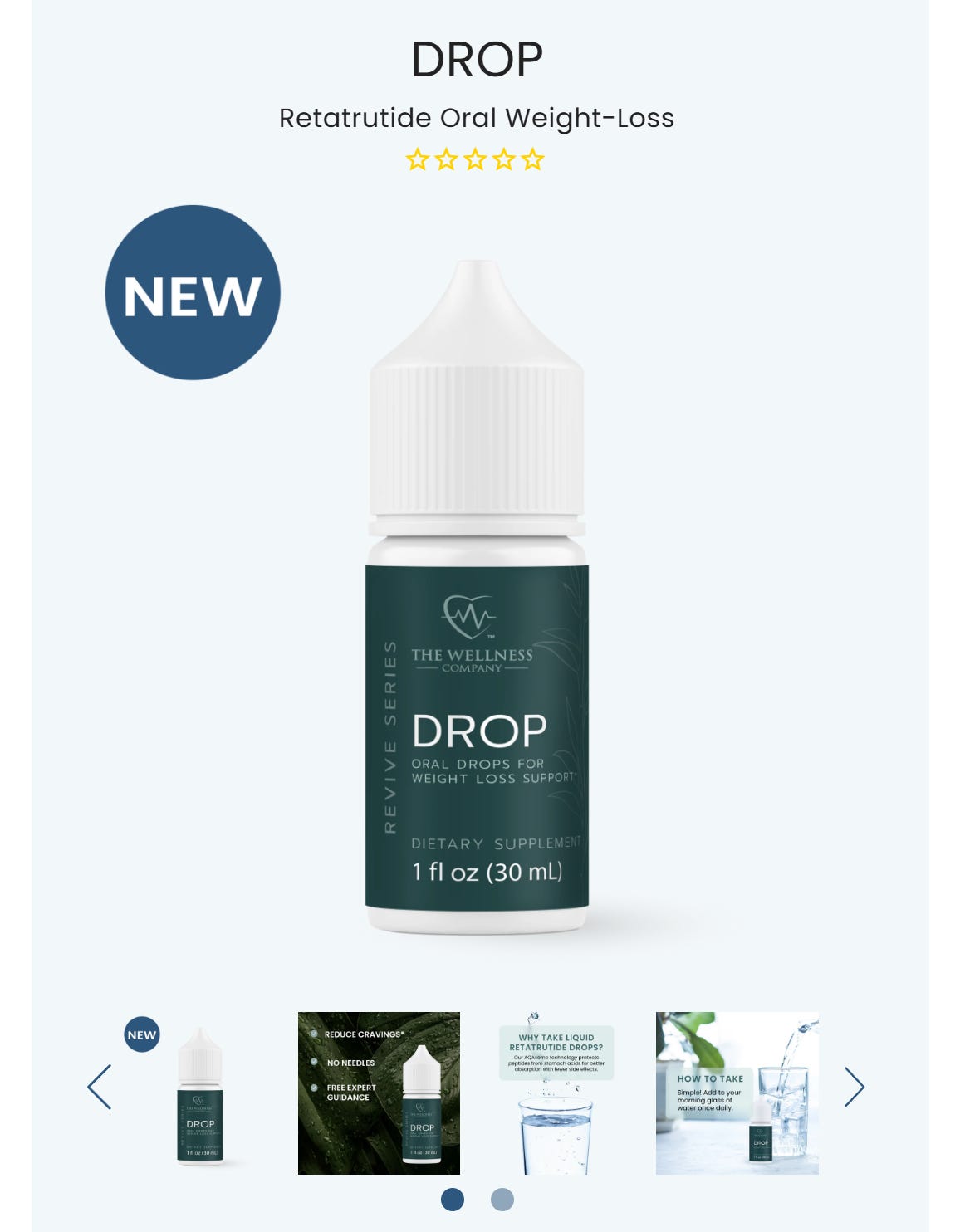By Peter A. McCullough, MD, MPH
Former White House correspondent John Solomon asked me about DROP, the popular solution offered by The Wellness Company as an adjunct to diet and exercise in losing weight. I said controlling food urges is key for a successful weight loss journey. Here is what Alter AI had on retatrutide the active ingredient in DROP.
Retatrutide: A Triple‑Agonist for Obesity and Metabolic Diseases
Introduction
Retatrutide (LY3437943; Eli Lilly) is a novel investigational agent that simultaneously activates three incretin‑related receptors—the glucose‑dependent insulinotropic polypeptide (GIP), glucagon‑like peptide‑1 (GLP‑1), and glucagon receptors. This “triple agonist” approach aims to combine potent glucose control and profound weight‑loss benefits while addressing metabolic dysfunction beyond the capabilities of current single or dual incretin mimetics (e.g., semaglutide or tirzepatide).
Mechanism of Action
Retatrutide binds and activates GIP, GLP‑1, and glucagon receptors with balanced agonism in vitro. GLP‑1R stimulation: enhances glucose‑dependent insulin secretion, slows gastric emptying, and reduces appetite. GIPR activation: synergizes Beta‑cell function and amplifies postprandial insulin and increases energy expenditure and fatty acid oxidation, offsetting the potential hyperglycemia of pure glucagon agonism. In preclinical studies, the combined engagement yielded greater body‑weight loss and glycogen mobilization than single‑pathway stimulation ¹.
Clinical Trials
Phase 2b Trial in Obesity (Jastreboff AM et al., NEJM 2023;389:601–612)
- Design: Randomized, double‑blind, placebo‑controlled (RCT) in 338 adults with obesity without diabetes.
- Intervention: once‑weekly subcutaneous Retatrutide 1 mg → 12 mg vs placebo for 48 weeks.
- Results: Mean weight loss at 48 weeks:
• 8 mg dose: –22.8 % body weight;
• 12 mg dose: –24.2 %; placebo: –2.1 %.
Two‑thirds of participants on ≥8 mg achieved ≥20 % loss — levels previously attainable only with bariatric surgery.
- Glycemia: Fasting glucose and HbA1c declined modestly even in nondiabetic subjects.
- Adverse events: Gastrointestinal symptoms (nausea, diarrhea) were most frequent and dose‑dependent; transient heart‑rate increase (+6 bpm) was typical of GLP‑1 agonists. No severe hypoglycemia or pancreatitis signals detected.
Phase 2 Trial in Type 2 Diabetes (Markus M et al., ADA Scientific Sessions 2024)
- Retatrutide 15 mg weekly for 24 weeks lowered HbA1c by 2.2 percentage points and body weight by 17 %.
Outcomes surpassed tirzepatide comparators in head‑to‑head exploratory arms.
Pharmacokinetics and Formulation Development
Currently, Retatrutide is in clinical trials only as a once‑weekly subcutaneous injection.
Its half‑life of approximately 6 days permits weekly dosing analogous to semaglutide and tirzepatide. Because the naked peptide is 38 amino acids long and heavily modified, poor bioavailability is anticipated because first‑pass metabolism is substantial. However with modifications, oral delivery is on the drug company radar screen. Eli Lilly has confirmed this is a viable delivery method ².
DROP from The Wellness Company
Thus the opportunity for oral retatrutide in DROP from The Wellness Company is its unique formulation in an encapsulated “AQAsome” sphere that allows it to bypass first pass metabolism. This allows for a very small dose (0.6 mg/day [4.2 mg/week] at 30 drops) compared to 15 mg/week when given by injection. Side effects are directly related to dose of GLP drugs.
An aquasome has a unique three-part structure:
A solid nanocrystalline core: Typically made of materials like calcium phosphate, ceramic, or diamond, the core provides structural stability to the nanoparticle.
A polyhydroxy oligomer coating: Common coating materials include trehalose or other carbohydrates. This layer protects the enclosed drug from degradation, especially from dehydration.
Adsorbed bioactive molecules: The drug or molecule is loaded onto the outer surface of the carbohydrate coating through a process of physical adsorption
Comparative Efficacy
Injectable retatrutide’s mean 24 % weight reduction surpasses the ~21 % achieved with semaglutide 2.4 mg (WILLOW trial) and ~22 % with tirzepatide 15 mg (SURMOUNT‑1). Its lipid profile shows reduced triglycerides (–38 %) and small LDL particles, likely mediated through glucagon‑induced fat oxidation. Blood pressure and uric acid also declined. Preliminary hepatic data show improved ALT and liver fat fraction, suggesting utility in metabolic‑associated steatotic liver disease (MASLD) ³.
Safety Profile
Across trials of the injectable form, the most common adverse events are nausea (44 %), diarrhea (32 %), constipation, and vomiting, usually during dose escalation. Mild heart‑rate increase, possible lean‑mass loss, and transient amylase/lipase rises require monitoring. Contraindications mirror those of GLP‑1 agents (MEN‑2, medullary thyroid carcinoma risk). Long‑term cardiovascular‑outcome trials (CVOTs) are ongoing.
Future Perspective
The Wellness Company DROP formulation is on the vanguard of GLP products that do not require an injection and can be self-adjusted daily. I found that to be key for success without side effects. One patient in my practice has lost 90 lbs with skilled use of DROP in addition to diet and exercise.
References
1. Finan B et al. Science Transl Med. 2019;11(507):eaav4596.
2. Eli Lilly Press Release, “Lilly Presents New Data on Retatrutide,” ADA 2024 Newsroom [July 2024].
3. Jastreboff AM et al. New Engl J Med. 2023;389:601–612.
4. Frias JP et al. Diabetes Care. 2024;47:1542‑1550.
5. Garvey WT et al. Lancet Diabetes Endocrinol. 2024;12:41‑54.












